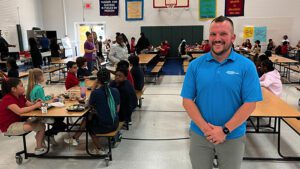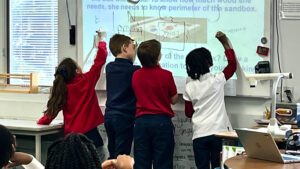Windemere Park Charter Academy
Lansing’s Windemere Park Charter Academy promotes rigorous attention to data to foster individualized attention to students’ needs.
By Patricia Montemurri
“Notice and wonder,” teacher Itzel Ostos-Newton instructs her 3rd graders at Windemere Park Charter Academy in Lansing during a May math class. “Notice and wonder!”
There’s an image of a sandbox on the board.
Hands shoot up in the air. “It’s a square!” says one student. Says another: “I wonder what the length and the width of the sandbox is?”
“Ooooh, I love that,” responds Ostos-Newton as her students, whom she calls ‘scholars,’ respond with more observations. She reveals a word problem: How much wood is needed to build a sandbox with 3-feet-long sides? She translates in Spanish to two newcomer English Learners. Several minutes later, four other students are up front, their worksheets with their problem-solving methodologies projected on the board.
In the 2021-2022 school year, Windemere Park 3rd graders from economically disadvantaged households scored above state averages on the M-STEP proficiency standards in Math and English Language Arts. The school’s foundation of instruction, built on rigorous evaluation of students’ progress in classroom assignments and assessments plus small group intervention, helped contribute to Windemere Park’s record of achievement.
For that same school year, Black students and students from low-income backgrounds in Windemere Park’s 6th grade and 8th grade also recorded above-average proficiency in English Language Arts. Its Black students in 8th grade also scored above average in Math.
Ostos-Newton says she talks straight with students about what the numbers say about their achievement.
“I use data in the classroom to drive my teaching. It helps me assess my scholars’ learning so I can adjust my instruction. Data is at the forefront of just about everything I do,” said Osnos-Newton. “In my classroom we talk about data a lot because I like my scholars having the responsibility of their grades and education.”
“We have very honest conversations about how we can improve, and we celebrate our growth. A lot of my students are intrinsically motivated, and we talk about ‘enjoying a slice of success cake,’” said Osnos-Newton.
“And I think their motivation comes from their involvement in these data conversations,” said Osnos-Newton, even when there is no actual cake involved. “It’s that feeling of achievement when you accomplish something.”
“I use data in the classroom to drive my teaching. It helps me assess my scholars’ learning so I can adjust my instruction. Data is at the forefront of just about everything I do.”
Teacher at Windemere Park Charter Academy

Small group teaching produces big results
At Windemere Park, a National Heritage Academies public charter school, there’s a focus on following a formula for academic success, including small group instruction, regularly assessing students’ learning, and interventions backed by data.
Principal Scott Greiner credits small group teaching with helping meet and identify students’ paths to achievement. Teachers follow NHA curriculum for every grade, but the classroom teachers, paraprofessionals and intervention specialists rotate through small groups or with individuals to fill in gaps or push them further.
“In our lower grades K-2, we have interventionists pushing into the classroom. You can see two adults in the classroom,” explained Greiner. “In grades 3-8, we do more of a pullout model where the classroom teacher is left with two groups, and then the interventionists pull out a small group.”
In teacher Ostos-Newton’s classroom, there are 90-minute blocks for English Language Arts and Math. Thirty minutes are set aside in each block for Osnos-Newton to have small groups rotate to her table – reteaching skills or concepts, reviewing strategies. The rest of the class is also at tables in small groups, working independently on lessons on laptops. Sometimes, she asks a student to help teach a table mate who hasn’t mastered a concept. Sometimes, said Ostos-Newton, “I find students learn best from each other.”
Data plus intervention can equal achievement
Kara McKone, Windemere Park’s dean over intervention and special education, oversees an intervention support team of 15 interventionists and paraprofessionals, who dig into data together.
“We have a systematic way of looking at data consistently, regularly,” said McKone. “We’re utilizing everyone’s expertise. When we see a concern or a need, we problem-solve, or we come up with strategies or a plan of action to address those needs. And so inevitably, that’s going to service all students from all backgrounds, all situations.”
Over the last decade, Windemere Park has become increasingly diverse. Windemere Park enrolled about 630 students in the 2022-2023 school year, up from 590 the previous year. About 40 percent of its students are Black and about 30 percent come from households that are Latino, Middle Eastern or Asian, said principal Greiner. Some 85 percent of its students are eligible for the free or reduced-price lunch federal program.
The school staff celebrates this diversity and honors the school culture through its instructional practices and materials. On Cultural Night at Windemere Park in June, there were tables with students displaying the foods and traditions of their family homelands – such as Jamaica, Ghana, Egypt, Colombia and Mexico. There were students who performed a traditional African dance.
On its classroom bookshelves and in lesson plans, said Principal Greiner, Windemere students can find stories that speak to their cultural and ethnic backgrounds. In its middle school grades, examples are “Brown Girl Dreaming” — a Young Adult book and Newbery Medal award winner by author Jacqueline Woodson about growing up African-American in South Carolina, Ohio and New York as the Civil Rights Movement took hold. “Long Walk to Water” by Linda Sue Park describes how two youngsters in South Sudan triumph through dangerous journeys. “Refugee,” by Alan Gratz, chronicles children’s exodus from violent homelands.
Additionally, understanding the diverse needs of their student body, the school staff tailors intervention to support each student’s unique needs.
“When we provide intervention services to students, we see that our services are equitable in the sense that we focus on the needs of the students and not who the student is,” said Greiner. The intervention is meant to target the skills needed.
McKone says she and the school’s three academic deans (one each overseeing grades K-2, grades 3-5 and grades 6-8), regularly visit classrooms to observe classroom instruction and act as instructional coaches.
“It definitely focuses on growing students through growing teachers,” said McKone. NHA provides resources and tools for those classroom observations, which are discussed in regular meetings with staff to provide “glows and grows.”
“It’s a checklist of things that should be observable,” explains McKone. “It gives timeframes for how much of the lesson this part should have [and] what questions should the teachers be asking,” explained McKone. “I’m checking things off. I’m circling things. I’m making comments.”
When she reviews the observation with a teacher or staff, McKone says, “I can provide the ‘glows’ – the things that went really well.” She also provides the “grows” — such as how to help a student who was having difficulty.
McKone credits National Heritage Academies’ curriculum for student achievement. That, combined with individualized instruction, is part of the formula for the school’s exceptional achievement results.
“In my first couple of years of coaching, it was making sure we were implementing the curriculum with fidelity,” said McKone.
“And then if we’re not seeing growth, what additional things do we need to try,” explained McKone. “Does the student need more visuals? Are they more of a hands-on learner? And so, it’s really digging deep into what strategies have you tried, could you try? What motivational factors do we need to help students? It’s the nitty-gritty.”
McKone says she routinely has “data-driven conversations” with interventionists, paraprofessionals, teachers and the school’s three academic deans (one each overseeing grades K-2, grades 3-5 and grades 6-8). The deans regularly make classroom visits.
Paraprofessionals often boost instruction with small student groups in her office, said McKone, “so I get a lot of opportunities to hear and see what’s going on.” Among the staff are veteran paraprofessionals, with decades of experience, who also provide advice, guidance and tips to newer staff.
McKone said the challenges that the Covid-19 pandemic wreaked on families, many of them from economically disadvantaged homes, sometimes made it harder for school families to be more involved with their children’s school.
That required, McKone said, “really owning the success of our students while they’re at school.”
In 2019, NHA created positions in each school for three behavior specialists to work with students to provide coping strategies and boost social emotional awareness. Their work was key in helping students adjust from the disruption caused by the pandemic, said McKone.


Summer school is vital for many
Another key to success is the school’s intentional effort to help students recover from the unfinished learning caused by Covid-19 when schools went virtual. That led to a robust summer program that Windemere Park offered during 2021 and 2022.
Before the pandemic, about 55 percent to 60 percent of National Heritage Academy schools provided summer schools.
In 2023, about 90 percent of NHA schools provided summer programs of four to six weeks, said Shawn Leonard, National Heritage Academy executive director of school quality. The increased summer programming is funded by federal dollars allocated to mitigate Covid-19 pandemic learning setbacks.
“Due to the pandemic, we have increased the number of students engaging in learning throughout the summer by both the number of schools and the access to content,” said Leonard. “In addition, the pandemic provided us the opportunity to align what students were learning with what occurred during the school year.”
That happened through data, said Leonard. Summer school teachers used assessment data to provide targeted instruction in ELA and Math.
“Teachers use data from the school year to develop a customized instructional sequence that is designed to help support closing specific learning gaps in preparation for the school year,” said Leonard. All NHA students, regardless of whether they go to summer school, have digital access to learning software to use at their own pace. Software such as DreamBox for Math, and Lexia and SORA for English are familiar from use during the school year and “help support core content instruction,” said Leonard.
“Through the pandemic, what we have learned is that what’s most important to support student learning during the school year,” said Leonard, “is important during the summer as well.”